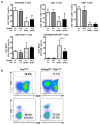Sh3bp2 Gain-Of-Function Mutation Ameliorates Lupus Phenotypes in B6.MRL- Faslpr Mice
- PMID: 31052273
- PMCID: PMC6562867
- DOI: 10.3390/cells8050402
Sh3bp2 Gain-Of-Function Mutation Ameliorates Lupus Phenotypes in B6.MRL- Faslpr Mice
Abstract
SH3 domain-binding protein 2 (SH3BP2) is an adaptor protein that is predominantly expressed in immune cells, and it regulates intracellular signaling. We had previously reported that a gain-of-function mutation in SH3BP2 exacerbates inflammation and bone loss in murine arthritis models. Here, we explored the involvement of SH3BP2 in a lupus model. Sh3bp2 gain-of-function (P416R knock-in; Sh3bp2KI/+) mice and lupus-prone B6.MRL-Faslpr mice were crossed to yield double-mutant (Sh3bp2KI/+Faslpr/lpr) mice. We monitored survival rates and proteinuria up to 48 weeks of age and assessed renal damage and serum anti-double-stranded DNA antibody levels. Additionally, we analyzed B and T cell subsets in lymphoid tissues by flow cytometry and determined the expression of apoptosis-related molecules in lymph nodes. Sh3bp2 gain-of-function mutation alleviated the poor survival rate, proteinuria, and glomerulosclerosis and significantly reduced serum anti-dsDNA antibody levels in Sh3bp2KI/+Faslpr/lpr mice. Additionally, B220+CD4-CD8- T cell population in lymph nodes was decreased in Sh3bp2KI/+Faslpr/lpr mice, which is possibly associated with the observed increase in cleaved caspase-3 and tumor necrosis factor levels. Sh3bp2 gain-of-function mutation ameliorated clinical and immunological phenotypes in lupus-prone mice. Our findings offer better insight into the unique immunopathological roles of SH3BP2 in autoimmune diseases.
Keywords: Fas; SH3 domain–binding protein 2; anti-dsDNA antibody; dendritic cells; double-negative T cells; lpr mutation; macrophages; murine lupus model; systemic lupus erythematosus; tumor necrosis factor.
Conflict of interest statement
A.N., T.M., K.K., S.T., and Y.M. received scholarship donations from Chugai Pharmaceutical Company. The funder had no role in the design of the study, collection, analyses, or interpretation of data, writing of the manuscript, or in the decision to publish the results.
Figures








Similar articles
-
SH3BP2 Deficiency Ameliorates Murine Systemic Lupus Erythematosus.Int J Mol Sci. 2021 Apr 17;22(8):4169. doi: 10.3390/ijms22084169. Int J Mol Sci. 2021. PMID: 33920631 Free PMC article.
-
Deletion of receptor for advanced glycation end products exacerbates lymphoproliferative syndrome and lupus nephritis in B6-MRL Fas lpr/j mice.J Immunol. 2015 Apr 15;194(8):3612-22. doi: 10.4049/jimmunol.1402342. Epub 2015 Mar 11. J Immunol. 2015. PMID: 25762779
-
MRL-lpr/lpr mice exhibit a defect in maintaining developmental arrest and follicular exclusion of anti-double-stranded DNA B cells.J Exp Med. 1999 Jun 7;189(11):1799-814. doi: 10.1084/jem.189.11.1799. J Exp Med. 1999. PMID: 10359584 Free PMC article.
-
Tumour necrosis factor and other cytokines in murine lupus.Ann Rheum Dis. 1999 Nov;58 Suppl 1(Suppl 1):I49-55. doi: 10.1136/ard.58.2008.i49. Ann Rheum Dis. 1999. PMID: 10577973 Free PMC article. Review. No abstract available.
-
Emerging Role of SH3BP2 as Regulator of Immune and Nonimmune Cells in Nephrotic Syndrome.Glomerular Dis. 2024 Nov 19;5(1):1-12. doi: 10.1159/000542703. eCollection 2025 Jan-Dec. Glomerular Dis. 2024. PMID: 39991193 Free PMC article. Review.
Cited by
-
SH3BP2 Deficiency Ameliorates Murine Systemic Lupus Erythematosus.Int J Mol Sci. 2021 Apr 17;22(8):4169. doi: 10.3390/ijms22084169. Int J Mol Sci. 2021. PMID: 33920631 Free PMC article.
-
CD138 promotes the accumulation and activation of autoreactive T cells in autoimmune MRL/lpr mice.Exp Ther Med. 2023 Oct 24;26(6):568. doi: 10.3892/etm.2023.12267. eCollection 2023 Dec. Exp Ther Med. 2023. PMID: 37954119 Free PMC article.
-
Loss-of-function OGFRL1 variants identified in autosomal recessive cherubism families.JBMR Plus. 2024 Apr 9;8(6):ziae050. doi: 10.1093/jbmrpl/ziae050. eCollection 2024 Jun. JBMR Plus. 2024. PMID: 38699440 Free PMC article.
-
Alveolar Bone Protection by Targeting the SH3BP2-SYK Axis in Osteoclasts.J Bone Miner Res. 2020 Feb;35(2):382-395. doi: 10.1002/jbmr.3882. Epub 2019 Oct 24. J Bone Miner Res. 2020. PMID: 31613396 Free PMC article.
-
Celastrol ameliorates lupus by promoting apoptosis of autoimmune T cells and preventing autoimmune response in MRL/lpr mice.Lupus Sci Med. 2024 Mar 11;11(1):e001057. doi: 10.1136/lupus-2023-001057. Lupus Sci Med. 2024. PMID: 38471722 Free PMC article.
References
Publication types
MeSH terms
Substances
Grants and funding
LinkOut - more resources
Full Text Sources
Medical
Molecular Biology Databases
Research Materials
Miscellaneous

